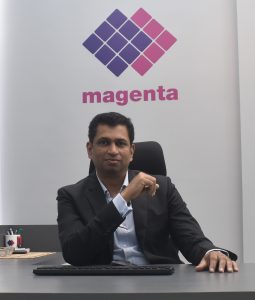With India targetting 500 GW of non-fossil fuel based energy and 50 per cent renewables in its energy mix by 2030, the clean energy industry hopes that this budget will address some of the key issues that the sector is facing including poor discom health, transmission constraints, lack of contract sanctity and policy uncertainty. Further, the industry hopes for adequate incentives to boost the domestic manufacturing capabilities of the country. Industry experts share their expectations for the clear energy sector…
Sanjeev Aggarwal, Managing Director & CEO, Amplus Solar
 “The industry expects long-term policy stability to promote investments in the sector and there are various areas where the budget can provide that stability. The weakest link at the distribution companies end still remains to be addressed and it will be prudent for the government to provide long term solution to ensure their viability so that the large scale power plants can continue to attract investments.
“The industry expects long-term policy stability to promote investments in the sector and there are various areas where the budget can provide that stability. The weakest link at the distribution companies end still remains to be addressed and it will be prudent for the government to provide long term solution to ensure their viability so that the large scale power plants can continue to attract investments.
Distributed solar is an important element of the energy transition and it will be useful for the country to provide tax rebates to the residential solar prosumers so that the solar rooftop and storage can pick up in a big way. Solar rooftop provides huge benefits like no new transmission requirement, utilisation of idle roof spaces and increased employment. This will also involve the citizens in a big way in fulfilling our Prime Minister’s vision of a green economy.”
Gyanesh Chaudhary, Vice-Chairman and Managing Director, Vikram Solar Ltd
 “The Government of India under the leadership of the Hon’ble Prime Minister, Shri Narendra Modi, has accelerated the transition to clean energy with solar adoption. This is evident from the achievement of the COP21 target of 40% renewables by 2030, nine years ahead of schedule. Solar (48.55 GW) has been at the forefront leading this transformation of India’s renewable landscape.
“The Government of India under the leadership of the Hon’ble Prime Minister, Shri Narendra Modi, has accelerated the transition to clean energy with solar adoption. This is evident from the achievement of the COP21 target of 40% renewables by 2030, nine years ahead of schedule. Solar (48.55 GW) has been at the forefront leading this transformation of India’s renewable landscape.
In order to achieve target of 500 GW renewable energy by 2030 announced at COP26 and enable the Aatmanirbhar Bharat vision, we are hopeful the Government will continue the targeted initiatives and policies to further strengthen the domestic solar manufacturing eco-system. This will accelerate economic recovery, create jobs, attract investments, increase exports, reduce dependence on imports and enable India’s Energy Security. To enhance global competitiveness of domestic solar manufacturers, the imposition of Basic Customs Duty (BCD) on solar cells & modules effective 1st April 2022, increasing the production-linked incentives (PLI) funding outlay for solar modules, enhancing the export incentive- Remission of Duties or Taxes on Export Product (RoDTEP) rates and ensuring it includes AA (Advance Authorisation) along with SEZ are critical policy interventions. We also urge the finance ministry to consider 5% Interest Subvention on term loans and working capital and upfront Central Financial Assistance of 30% on capex.
Further, to encourage domestic solar manufacturers to build scale with quality, the government should consider capital subsidy of 50% for setting up R&D and Quality testing infrastructure within the manufacturing unit and super deduction of 200 % for R&D expenses for solar technology development. The upcoming Budget must also consider allowing clearance from Special Economic Zones (SEZ) units to Domestic Tariff Areas (DTA) on a duty forgone basis. Additionally, we also recommend allowing conversion of SEZ units into DTA and permitting them to continue operating from the same infrastructure with enabling policies.”
Debi Prasad Dash, Executive Director, India Energy Storage Alliance
 “Recommendations for energy storage industry: Tax holidays which will boost the investment in the industry, and the exemptions on GST, customs and excise duty for next 2-3 years till the domestic manufacturing picks up in India would result in a reduction of overall system cost immediately. The tax incentives will support the industry for providing a reduced deployment cost in a long run with domestic manufacturing.
“Recommendations for energy storage industry: Tax holidays which will boost the investment in the industry, and the exemptions on GST, customs and excise duty for next 2-3 years till the domestic manufacturing picks up in India would result in a reduction of overall system cost immediately. The tax incentives will support the industry for providing a reduced deployment cost in a long run with domestic manufacturing.
Recommendations for E-mobility: Although GST rate on EV is reduced from 12% to 5%, GST for advanced batteries in EVs is still on the higher side ranging between 18% to 28%. Requested to bring down GST under 5% bracket in order to ensure affordability and smooth transition towards EVs from ICEs. Other recommendations include extending of Fame II incentivization towards charging infrastructure and battery swapping.
Recommendations for manufacturing, ACC PLI scheme, MSMEs and startups, skill development etc:
- It is requested to reduce duties for supply chain components including raw materials as well as manufacturing equipment: reduced rate to 5% minimum from higher duties.
- DHI bid for ACC PLI scheme has received tremendous response from the national and international investors – a total of 10 bids with capacity ~ 130 Gwh , which is 2.6 times the manufacturing capacity to be awarded. In order to achieve Prime Minister’s vision and utilize the interest from investors, it is requested to enhance the capacity of ACC manufacturing to 75 GWh under PLI scheme as well as increase the financial outlay amount . Similarly, it is also requested to consider increasing the capacity and financial outlay for planned niche ACC program under PLI to support new and advanced battery technologies to leapfrog the global technology race.
- It is requested to provide the infrastructure status to energy storage projects (covering both manufacturing and deployment) to facilitate promotion of domestic manufacturing and checking the imports.
- Support to intermediate material manufacturers: We strongly recommend the Ministry to consider export promotion investments. The government is requested to consider a capital investment subsidy, 20% of investment which can be capped at Rs 1 billion over period of 10 years or consider a separate PLI scheme for intermediate material manufacturing
- Incentivize MSME sector and start up ecosystem of energy storage and E-mobility: For faster growth of manufacturing capabilities in India, it is requested to extend other benefits like affordable funding and easy access, common facility centres for manufacturing, public procurement order etc to MSMEs. Dedicated funda to be allocated for the sector including hardware startups which needs commitment and funding.
- Introducing loan guarantee programs for high risk technology programs
- If the beneficiary firm in any accounting year shall fall short of the subsistence revenue as a result of any or all of non-political event, indirect political event and political event, as the case may be, the government shall, upon request of the beneficiary firm, provide a loan for meeting such shortfall (the “revenue shortfall loan”) at an interest rate equal to 2% above the bank rate.
- Government funding towards research and development for energy storage, not just for lithium-ion but for a variety of technologies including flow batteries, sodium-based batteries, zinc-air batteries, metal air batteries, green hydrogen etc.
- Skill development programs for senior level researchers as well as supervisory and junior level man power deployment
- Need for incentive-based scrapping policy to encourage voluntary scrapping of old vehicles.”
SK Gupta, CFO, Amp Energy India
 “Indian Renewable Industry continues to maintain high speed growth and play leadership role at Global level in pushing renewables. To help it sustain it’s journey of growth, Renewable Industry expects the 2022 Budget to further facilitate and provide imputes this growth by:
“Indian Renewable Industry continues to maintain high speed growth and play leadership role at Global level in pushing renewables. To help it sustain it’s journey of growth, Renewable Industry expects the 2022 Budget to further facilitate and provide imputes this growth by:
Driving local manufacturing prowess in renewables and making it technologically savvy to continuously optimise cost and efficiency to achieve lowest cost of power to society in the long run.
Provide adequate incentives and tax reliefs to industry to help India become a renewable manufacturing hub.
Availability of adequate and diverse long term funding avenues for the industry at most competitive terms.
Providing a stable and enabling policy landscape that can ensure sustainable investor interest and help speeder growth in less tapped C&I and battery segments.
Further strengthening transmission and storage infrastructure so that various renewable options can integrate for a more sustained and cost effective green power environment in the country.
GST roll back on renewable equipment’s to 5 % from 12 %.”
Amit Jain, Global CEO – Sterling and Wilson Renewable Energy
 “With this year’s budget, we have more expectations from the government with regards to renewable energy which can spur the growth of the sector.
“With this year’s budget, we have more expectations from the government with regards to renewable energy which can spur the growth of the sector.
PLI Schemes will be incentivised, due to which module manufacturing will go up. Hence, we are expecting allocation towards module manufacturing. The government should come up with RTC tenders. With the increasing prices of batteries, government should put efforts in this direction. There should be an increase in the PLI amounts for manufacturing batteries in India.
Clearance of pending discom bills should be resolved and more budgetary allocation to be made to improve the fiscal health of electricity distribution companies. We expect the electricity sector to be brought under the ambit of GST and solar contracts with multiple slabs to be streamlined to a single slab. This will help to reduce the cost of solar installation and reduce ambiguity in the sector. We are expecting new policies around green hydrogen. While the National Hydrogen Policy and a few pilot projects are encouraging initiatives, the buzz now needs to be converted to action on the ground. Allocation to incentivise cheaper production of green hydrogen is needed since the economy will be centered around it.”
Awadhesh Jha, Executive Director, Fortum Charge & Drive India Pvt. Ltd.
 “We anticipate a strong growth-oriented Union Budget 2022-23, which gives a much-needed fillip to the economy. We have great expectations and hope that the government will continue to take the necessary steps to put India on the global electric vehicle map. The government has demonstrated its support for EVs through various initiatives such as the National Electric Mobility Mission plan 2020 and capital subsidies under FAME, plus the recent Production Linked Incentive Scheme (PLI) scheme. While this will help local manufacturing, the government should also consider increasing domestic demand by incentivising individual passenger EV adoption across the country through FAME-II scheme.
“We anticipate a strong growth-oriented Union Budget 2022-23, which gives a much-needed fillip to the economy. We have great expectations and hope that the government will continue to take the necessary steps to put India on the global electric vehicle map. The government has demonstrated its support for EVs through various initiatives such as the National Electric Mobility Mission plan 2020 and capital subsidies under FAME, plus the recent Production Linked Incentive Scheme (PLI) scheme. While this will help local manufacturing, the government should also consider increasing domestic demand by incentivising individual passenger EV adoption across the country through FAME-II scheme.
Redirected policies towards ease of financing, reduction in GST from 18% to 5% and additional supportive steps on enhancing the EV public charging infrastructure through greater participation from private sector will benefit the sector. Making a statutory provision for sourcing the power through open access for meeting the EV charging need by charge point operator shall go a long way in meeting our net zero emission goal.”
Maxson Lewis, Managing Director and CEO, Magenta
 “The fundamental key expectation that we have from Budget 2022 is that charging infrastructure in the country should be enabled at a faster rate. We hope the FAME scheme will increasingly encompass EV charging infrastructure a lot more than what we see in the preceding years.
“The fundamental key expectation that we have from Budget 2022 is that charging infrastructure in the country should be enabled at a faster rate. We hope the FAME scheme will increasingly encompass EV charging infrastructure a lot more than what we see in the preceding years.
In terms of EV charging, we expect that the Budget will address the critical issue of addressing the electrification of EV charging via open access, as well as the associated taxation and wheeling costs. This will necessitate a rethinking of the CERC and open access through the perspective of the permitted activity. To reduce working capital constraints in the EV charger manufacturing business, the government could offer end-use-based advantages to the EV industry, such as cutting GST rates on raw materials and permitting duty-free imports, refunds for research and development, as well as capital spending on EV chargers. We would want to urge the government to grant R&D incentives to EV companies. Given the government’s Aatmanirbhar India aim, India must take the lead in creating innovative technologies that will alter the EV industry. To make this happen, the government should incentivise industries and academia to collaborate.
To fulfill India’s full potential and transition to an age of electric vehicle mobility, it is critical that all key parties acknowledge the importance of the problem and work together to make it a reality by integrating all elements.”
Rajiv Ranjan Mishra, Managing Director, Apraava Energy
 “India’s progress in the renewable energy space over the years has been truly remarkable. We are one of the most attractive investment destinations in the world today for renewable energy. The industry is looking forward to the upcoming Union Budget with certain expectations. We hope that the government resolves the financial issues of distribution companies finances and ensures that contracts that were awarded are respected on the fiscal front. Seeing the excellent response that PLI schemes have attracted, we would like for them to be extended into the future as well. We would also like import duties on items like batteries and electrolytes to be lowered so that we can strengthen our capabilities in areas like green technologies and hydrogen. Last, but not the least, we request that electricity be included in the ambit of GST, as it will result in the reduction of costs and ultimately benefit India’s consumers.”
“India’s progress in the renewable energy space over the years has been truly remarkable. We are one of the most attractive investment destinations in the world today for renewable energy. The industry is looking forward to the upcoming Union Budget with certain expectations. We hope that the government resolves the financial issues of distribution companies finances and ensures that contracts that were awarded are respected on the fiscal front. Seeing the excellent response that PLI schemes have attracted, we would like for them to be extended into the future as well. We would also like import duties on items like batteries and electrolytes to be lowered so that we can strengthen our capabilities in areas like green technologies and hydrogen. Last, but not the least, we request that electricity be included in the ambit of GST, as it will result in the reduction of costs and ultimately benefit India’s consumers.”
 “It is expected from budget 2022 that the solar industry will boom with a potential investment of over USD 15 billion. As the government concentrates on electric cars, green hydrogen, manufacturing solar equipment, and meeting the ambitious 175GW renewable capacity target, the solar industry is predicted to expand in 2022. In my opinion, the Union Budget for 2022-2023 should include tax breaks and credit guarantees to encourage technology adoption in the solar power industry.
“It is expected from budget 2022 that the solar industry will boom with a potential investment of over USD 15 billion. As the government concentrates on electric cars, green hydrogen, manufacturing solar equipment, and meeting the ambitious 175GW renewable capacity target, the solar industry is predicted to expand in 2022. In my opinion, the Union Budget for 2022-2023 should include tax breaks and credit guarantees to encourage technology adoption in the solar power industry.
Abhishek Nath, Sector Head – Energy and Power Sector, CSTEP
 “We should look at the upcoming budget in the backdrop of India’s Glasgow commitments. To get to 500 GW non-fossil energy and 50% of the electricity supply from renewables, both by 2030, we need to start building capacity now. In the upcoming budget we will certainly see a push for matured technologies like solar and wind in addition to push towards upcoming technologies like green hydrogen, the policy for which is eagerly awaited. However, while pushing these technologies forward we would like to see steps to ensure that the impact of these technologies on ecological, social and economic milieu is kept at the minimum. Siting and material use for green energy should be an important consideration, and this should be enunciated in tandem with the fiscal measures to boost the uptake of these technologies. What we do not want, is, to create power sector infrastructure that we will again have to phase out by the next 25-30 years.”
“We should look at the upcoming budget in the backdrop of India’s Glasgow commitments. To get to 500 GW non-fossil energy and 50% of the electricity supply from renewables, both by 2030, we need to start building capacity now. In the upcoming budget we will certainly see a push for matured technologies like solar and wind in addition to push towards upcoming technologies like green hydrogen, the policy for which is eagerly awaited. However, while pushing these technologies forward we would like to see steps to ensure that the impact of these technologies on ecological, social and economic milieu is kept at the minimum. Siting and material use for green energy should be an important consideration, and this should be enunciated in tandem with the fiscal measures to boost the uptake of these technologies. What we do not want, is, to create power sector infrastructure that we will again have to phase out by the next 25-30 years.”
Faizur Rehman, Country Director, Chempolis India and Head, Bio2X, Fortum India
 “With the government’s keen focus towards mandating automakers to offer biofuel vehicles in the next six months and directives to oil CPSEs to set up Second Generation (2G) Ethanol Bio-refineries in different parts of the country using agri-residues and biomass, we anticipate the upcoming Union Budget 2022-23 to provide impetus and policies for promoting the manufacturing of second generation (2G) biofuels across the country.
“With the government’s keen focus towards mandating automakers to offer biofuel vehicles in the next six months and directives to oil CPSEs to set up Second Generation (2G) Ethanol Bio-refineries in different parts of the country using agri-residues and biomass, we anticipate the upcoming Union Budget 2022-23 to provide impetus and policies for promoting the manufacturing of second generation (2G) biofuels across the country.
We expect the budget to propose schemes and initiatives that will propel investments and growth opportunities to the sectors of our operations, especially relating to bio-based solutions to curb carbon emissions through conversion of biowaste into valuable end products, such as second generation (2G) biofuels. We will continue to operate in line with the government’s vision to usher in combined growth of India’s economy and our business.”
Kush Singh, CEO, Essar Power
 “As a player in the energy and power sector, we are really hopeful that the Union Budget 2022-23 will set a path to recovery beginning this year. The energy sector is pinning a lot of hopes that the upcoming budget shall offer the much-needed push to the revival of consumer confidence especially in renewable energy sector.
“As a player in the energy and power sector, we are really hopeful that the Union Budget 2022-23 will set a path to recovery beginning this year. The energy sector is pinning a lot of hopes that the upcoming budget shall offer the much-needed push to the revival of consumer confidence especially in renewable energy sector.
The Union Budget 2022-23 must focus on incentivising technology adoption in the renewable energy sector through tax concessions and credit guarantee. For the entire renewable industry to grow, structural incentives need to be built in the ecosystem, to both, enable the industry as well as the consumers to adopt and utilize technology efficiently. Whether it’s related to EV usage, investment in battery, lithium imports, lithium convertor and lithium refinery set up, green hydrogen adoption, it is very imperative that the high costs associated initially with these technologies are socialized and given enough government protection.
The Government has an ambitious target of increasing the renewables installed capacity to 430 GW by 2030 and at the same time increased the GST on solar modules from 5% to 12%, which should certainly be reconsidered, as huge investments have been planned in this sector going forward. There is also a need to bring the generation and sale of power under the purview of GST.
Another important step we hope is taken, is utilizing the GST compensation cess for making the existing coal based plants environmentally compliant by installing FGDs. Allocating money in grants will avoid the need to increase tariffs and will be a positive move by the government to mitigate pollution.
Additionally, if we look at strengthening the interstate transmission network, it will help to restrict the grid curtailment and ensure the power flow from renewable rich states to other states with waivers of inter and intra state transmission charges.
Going forward, there will be a much anticipated shift in the energy sector, with the focus on ESG and renewables, thus the steps taken from now on should complement that change. To start with, we expect the government to consider reducing custom duty on electrolysers required for green hydrogen generation, in order to make India a global manufacturing hub.”



